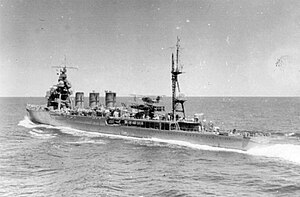Japanese cruiser Abukuma

Abukuma in 1941, showing Kawanishi E7K1 "Alf" floatplane on catapult, ready to launch
|
|
| History | |
|---|---|
|
|
|
| Name: | Abukuma |
| Ordered: | 1920 Fiscal Year (1918 “8-6 Fleet” Plan) |
| Builder: | Uraga Dock Company |
| Laid down: | 8 December 1921 |
| Launched: | 16 March 1923 |
| Commissioned: | 26 May 1925 |
| Struck: | 20 December 1944 |
| Fate: |
|
| General characteristics | |
| Class and type: | Nagara-class cruiser |
| Displacement: | 5,570 long tons (5,659 t) normal |
| Length: | |
| Beam: | 14.2 m (46 ft 7 in) |
| Draft: | 4.8 m (15 ft 9 in) |
| Propulsion: |
|
| Speed: | 36 knots (41 mph; 67 km/h) |
| Range: | 6,000 nmi (11,000 km) at 14 kn (26 km/h) |
| Complement: | 450 |
| Sensors and processing systems: |
Type 21 air-search radar |
| Armament: |
|
| Armor: |
|
| Aircraft carried: | 1 x floatplane |
| Aviation facilities: | 1x aircraft catapult |
Abukuma (阿武隈?) was the sixth and last of the vessels completed for the Imperial Japanese Navy (IJN) in the Nagara class of light cruisers, and like other vessels of her class, she was intended for use as the flagship of a destroyer flotilla. She was named after the Abukuma River in the Tōhoku region of Japan. She saw action during World War II in the Attack on Pearl Harbor and in the Pacific, before being disabled in the Battle of Surigao Strait in October 1944, then bombed and sunk by the United States Army Air Forces (USAAF) off the coast of the Philippines.
Following the production of the five Kuma-class cruisers, an additional three 5,500-ton class light cruisers authorized under the 8-4 Fleet Program were ordered by the Imperial Japanese Navy in 1920. Due to minor changes in design, primarily due to advances in torpedo technology, these three vessels were initially designated as “modified Kuma-class”, or “5500-ton class Type II”, before being re-designated as a separate class named after the lead vessel, Nagara. A second set of three vessels was authorized in late 1920.
The Nagara-class vessels were essentially identical to the previous Kuma-class cruisers, retaining the same hull design, engines and main weaponry, with the addition of the new 610 mm Type 93 Long Lance Torpedoes, which required a larger launcher. However, in silhouette, a major difference from the Kuma class was in the configuration of the bridge, which incorporated an aircraft hangar. Initially, a 33-foot platform was mounted above the No.2 turret, extending over the forward superstructure below the bridge. This was later replaced by an aircraft catapult. Even so, the arrangement proved unwieldy, and the catapult was moved to the rear of each ship in the class, between the No.5 and No.6 turrets during retrofits in 1929-1934. Abukuma and Kinu, were scheduled to receive the new Type 93 torpedoes in early 1941. However, shortages meant that only Abukuma was refitted quadruple mounts in place of the aft twin mounts between March and May 1941, and her forward twin mounts were removed. Abukuma carried sixteen Type 93 torpedoes, including eight reloads.Abukuma was also the first vessel in her class to receive radar (in 1943) .
...
Wikipedia
